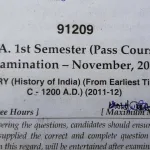The RTMNU bsc 1st semester question papers provide all subject questions with answer. Today we will cover all subjects for all bsc students who are appearing for rtmnu bsc 1st semester exam.
List of Subjects Covered for RTMNU Bsc 1st Sem Question Papers
- Physics
- Chemistry
- Mathematics
- Botany
- Zoology
- Computer Science
Physics
Physics is one of the core subjects in the B.Sc. curriculum. Here’s a look at some sample questions and answers:
Sample Questions and Answers:
Question: Define Newton’s first law of motion.
Answer: Newton’s first law of motion states that an object will remain at rest or in uniform motion in a straight line unless acted upon by an external force.
Question: What is the formula for calculating kinetic energy?
Answer: The formula for kinetic energy is KE = 1/2 mv^2, where ‘m’ is the mass and ‘v’ is the velocity of the object.
Question: Explain the concept of potential energy.
Answer: Potential energy is the energy possessed by an object due to its position or condition. For example, a stone held at a height has gravitational potential energy.
Question: What is Ohm’s Law?
Answer: Ohm’s Law states that the current flowing through a conductor between two points is directly proportional to the voltage across the two points. The formula is V = IR, where ‘V’ is voltage, ‘I’ is current, and ‘R’ is resistance.
Question: Define and explain the principle of conservation of energy.
Answer: The principle of conservation of energy states that energy cannot be created or destroyed, only transformed from one form to another. The total energy in a closed system remains constant.
Question: What is the unit of electric charge?
Answer: The unit of electric charge is the Coulomb (C).
Question: Describe the photoelectric effect.
Answer: The photoelectric effect is the emission of electrons from a material when light of sufficient frequency shines on it. This effect demonstrates the particle nature of light.
Question: What is the speed of light in a vacuum?
Answer: The speed of light in a vacuum is approximately 3 x 10^8 meters per second.
Question: Explain the term ‘work’ in physics.
Answer: In physics, ‘work’ is defined as the transfer of energy when a force is applied to an object causing it to move. The formula is Work = Force x Distance.
Question: What is Hooke’s Law?
Answer: Hooke’s Law states that the force needed to extend or compress a spring by some distance is proportional to that distance. The formula is F = kx, where ‘F’ is the force, ‘k’ is the spring constant, and ‘x’ is the displacement.
Chemistry
Chemistry involves the study of matter, its properties, and the changes it undergoes. Here are some important questions and answers:
Sample Questions and Answers:
Question: What is the atomic number?
Answer: The atomic number is the number of protons in the nucleus of an atom, which determines the chemical properties of an element and its place in the periodic table.
Question: Define molarity.
Answer: Molarity is a measure of the concentration of a solute in a solution. It is defined as the number of moles of solute per liter of solution (mol/L).
Question: What is the chemical formula for water?
Answer: The chemical formula for water is H2O.
Question: Explain the law of conservation of mass.
Answer: The law of conservation of mass states that mass in an isolated system is neither created nor destroyed by chemical reactions or physical transformations. The mass of the products in a chemical reaction must equal the mass of the reactants.
Question: What is Avogadro’s number?
Answer: Avogadro’s number is 6.022 x 10^23, which is the number of atoms, molecules, or particles in one mole of a substance.
Question: Define pH.
Answer: pH is a scale used to specify the acidity or basicity of an aqueous solution. It is the negative logarithm of the hydrogen ion concentration.
Question: What is a covalent bond?
Answer: A covalent bond is a chemical bond that involves the sharing of electron pairs between atoms.
Question: What is the periodic table?
Answer: The periodic table is a tabular arrangement of the chemical elements, organized by increasing atomic number, electron configurations, and recurring chemical properties.
Question: Explain the difference between an ionic bond and a covalent bond.
Answer: An ionic bond is formed when one atom transfers electrons to another atom, while a covalent bond is formed when two atoms share electrons.
Question: What is a catalyst?
Answer: A catalyst is a substance that increases the rate of a chemical reaction without being consumed in the process.
Mathematics
Mathematics is a fundamental subject in the B.Sc. curriculum, focusing on developing analytical and problem-solving skills. Here are some sample questions and answers:
Sample Questions and Answers:
Question: Solve the equation 2x + 3 = 7.
Answer: x = 2.
Question: What is the derivative of f(x) = x^2?
Answer: The derivative of f(x) = x^2 is f'(x) = 2x.
Question: Find the integral of f(x) = 3x^2.
Answer: The integral of f(x) = 3x^2 is F(x) = x^3 + C, where C is the constant of integration.
Question: Define a matrix.
Answer: A matrix is a rectangular array of numbers arranged in rows and columns.
Question: What is the formula for the area of a circle?
Answer: The formula for the area of a circle is A = πr^2, where ‘r’ is the radius.
Question: Solve for x: x^2 – 4x + 4 = 0.
Answer: x = 2 (double root).
Question: What is the Pythagorean theorem?
Answer: The Pythagorean theorem states that in a right-angled triangle, the square of the length of the hypotenuse (the side opposite the right angle) is equal to the sum of the squares of the lengths of the other two sides. The formula is a^2 + b^2 = c^2.
Question: Define a vector.
Answer: A vector is a quantity that has both magnitude and direction.
Question: What is the binomial theorem?
Answer: The binomial theorem describes the algebraic expansion of powers of a binomial. The formula is (a + b)^n = Σ (n choose k) a^(n-k) b^k, where Σ denotes summation and (n choose k) is a binomial coefficient.
Question: What is the quadratic formula?
Answer: The quadratic formula is x = (-b ± √(b^2 – 4ac)) / 2a, used to solve quadratic equations of the form ax^2 + b^2 + c = 0.
Botany
Botany, the study of plants, is an essential subject in the B.Sc. curriculum. Here are some important questions and answers:
Sample Questions and Answers:
Question: What is photosynthesis?
Answer: Photosynthesis is the process by which green plants and some other organisms use sunlight to synthesize foods with the help of chlorophyll. The formula is 6CO2 + 6H2O + light energy = C6H12O6 + 6O2.
Question: Define transpiration.
Answer: Transpiration is the process of water movement through a plant and its evaporation from aerial parts, such as leaves, stems, and flowers.
Question: What is the function of the xylem?
Answer: The xylem is responsible for the transport of water and minerals from the roots to the rest of the plant.
Question: What are stomata?
Answer: Stomata are small openings on the surfaces of leaves and stems that allow for gas exchange.
Question: Explain the term ‘germination’.
Answer: Germination is the process by which a seed develops into a new plant.
Question: What is chlorophyll?
Answer: Chlorophyll is a green pigment found in the chloroplasts of plants, algae, and cyanobacteria. It is essential for photosynthesis.
Question: Define pollination.
Answer: Pollination is the transfer of pollen from the male part of a flower (anther) to the female part of a flower (stigma).
Question: What is the botanical name for sunflower?
Answer: The botanical name for sunflower is Helianthus annuus.
Question: What is a dicot plant?
Answer: A dicot plant is a plant that has two seed leaves or cotyledons upon germination. Examples include beans and roses.
Question: Explain the term ‘hybridization’.
Answer: Hybridization is the process of crossing two different species or varieties to produce a hybrid.
Zoology
Zoology, the study of animals, is another core subject. Here are some sample questions and answers:
Sample Questions and Answers:
Question: What is the scientific name of the human being?
Answer: The scientific name of the human being is Homo sapiens.
Question: Define taxonomy.
Answer: Taxonomy is the science of classification of organisms into systematically arranged categories based on their relationships.
Question: What is the function of the mitochondria?
Answer: Mitochondria are the powerhouses of the cell, responsible for producing energy through cellular respiration.
Question: Explain the term ‘ecosystem’.
Answer: An ecosystem is a community of living organisms in conjunction with the non-living components of their environment, interacting as a system.
Question: What is the role of DNA?
Answer: DNA (deoxyribonucleic acid) carries genetic information used in growth, development, functioning, and reproduction of all living organisms and many viruses.
Question: What is natural selection?
Answer: Natural selection is the process by which organisms better adapted to their environment tend to survive and produce more offspring.
Question: Define mutation.
Answer: A mutation is a change in the DNA sequence of an organism’s genome.
Question: What is a vertebrate?
Answer: A vertebrate is an animal that has a backbone or spinal column. Examples include mammals, birds, reptiles, amphibians, and fish.
Question: What is symbiosis?
Answer: Symbiosis is an interaction between two different organisms living in close physical association, typically to the advantage of both.
Question: Explain the term ‘homeostasis’.
Answer: Homeostasis is the ability of an organism or environment to maintain stability in spite of changes.
Computer Science
Computer Science is an important subject in the B.Sc. curriculum, focusing on programming and computational theory. Here are some important questions and answers:
Sample Questions and Answers:
Question: What is a computer program?
Answer: A computer program is a set of instructions that a computer follows to perform a task.
Question: Define an algorithm.
Answer: An algorithm is a step-by-step procedure or formula for solving a problem.
Question: What is the function of the CPU?
Answer: The CPU (Central Processing Unit) is the primary component of a computer that performs most of the processing inside the computer.
Question: What is a database?
Answer: A database is an organized collection of data, generally stored and accessed electronically from a computer system.
Question: What is an operating system?
Answer: An operating system (OS) is system software that manages computer hardware, software resources, and provides common services for computer programs.
Question: Explain the term ‘networking’.
Answer: Networking refers to the practice of connecting computers and other devices together to share resources and information.
Question: What is a programming language?
Answer: A programming language is a formal language comprising a set of instructions that produce various kinds of output, used in computer programming to implement algorithms.
Question: What is the World Wide Web?
Answer: The World Wide Web (WWW) is an information system where documents and other web resources are identified by URLs, interlinked by hypertext links, and accessible via the internet.
Question: Define software.
Answer: Software is a collection of data or computer instructions that tell the computer how to work. This is in contrast to hardware, from which the system is built and which actually performs the work.
Question: What is HTML?
Answer: HTML (HyperText Markup Language) is the standard markup language for documents designed to be displayed in a web browser.
Formulas and Equations
Here’s a list of important formulas and equations that are often used in the B.Sc. 1st Semester:
Physics Formulas:
- Kinetic Energy: KE = 1/2 mv^2
- Potential Energy: PE = mgh
- Ohm’s Law: V = IR
- Work: Work = Force x Distance
- Hooke’s Law: F = kx
- Speed of Light: c = 3 x 10^8 m/s
Chemistry Formulas:
- Molarity: M = moles of solute / liters of solution
- Avogadro’s Number: 6.022 x 10^23
- Photosynthesis: 6CO2 + 6H2O + light energy = C6H12O6 + 6O2
- Ideal Gas Law: PV = nRT
Mathematics Formulas:
- Area of a Circle: A = πr^2
- Pythagorean Theorem: a^2 + b^2 = c^2
- Quadratic Formula: x = (-b ± √(b^2 – 4ac)) / 2a
- Derivative of x^2: d/dx (x^2) = 2x
RTMNU Bsc 1st Sem Question Papers Short Information
| Subject | Key Concepts | Formulas/Definitions |
|---|---|---|
| Physics | Newton’s Laws, Energy, Electricity | KE = 1/2 mv^2, V = IR |
| Chemistry | Atomic Structure, Bonds, Solutions | M = moles/L, PV = nRT |
| Mathematics | Algebra, Calculus, Geometry | A = πr^2, Pythagorean Theorem |
| Botany | Photosynthesis, Germination | Photosynthesis formula, Xylem |
| Zoology | Taxonomy, DNA, Homeostasis | Scientific Names, Symbiosis |
| Computer Sci. | Programming, Databases, Networking | Algorithm, CPU, HTML |
Types of Questions Asked in RTMNU Bsc 1st Sem Question Papers
In the RTMNU B.Sc. 1st Semester exams, the questions can range from basic definitions and explanations to problem-solving and application-based queries. Here’s a breakdown:
- Multiple Choice Questions (MCQs): Test basic concepts and facts.
- Short Answer Questions: Require brief explanations, definitions, and examples.
- Long Answer Questions: Involve detailed explanations, derivations, and problem-solving.
Exam Pattern for RTMNU Bsc 1st Sem Question Papers
The RTMNU B.Sc. 1st Semester exams generally follow a structured pattern. The question paper is divided into several sections, including:
- Multiple Choice Questions (MCQs)
- Short Answer Questions
- Long Answer Questions
Each section tests different aspects of the students’ understanding and knowledge. The total marks for the exam usually range from 70 to 100, and the duration is 3 hours. By understanding the exam pattern and practicing with these sample questions and answers, students can better prepare for their B.Sc. 1st Semester exams. Best of luck for your exam!
Latest Posts
- Step-by-step guide to download and apply for jee mains admit card 202
- Comprehensive 2025 government holidays and recruitment details for job seekers
- JEE Mains Admit Card 2025: Your Step-by-Step Guide to Downloading the Hall Ticket
- Everything You Need to Know About 2025 Government Holidays Recruitment
- Comprehensive Guide to rrb d group recruitment 2025 – Eligibility, Vacancies, and Application
- Detailed guide to nps trust recruitment 2025 vacancies, eligibility and apply process
- Comprehensive guide to hpcl recruitment 2025 notification, vacancies, and application process
- ignou bed admission 2025 complete recruitment guide with eligibility and process
- Comprehensive Guide to Indian Army Agniveer Recruitment 2025 Notification and Jobs
- Everything You Must Know About CBSE Board Exams 2025 Changes & New Rules





